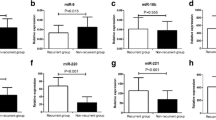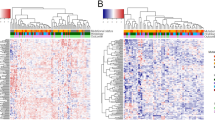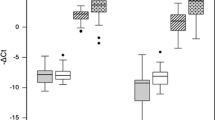Abstract
Background
Papillary thyroid carcinoma (PTC) has relatively indolent behavior, although some tumors recur and disseminate to distant sites. The aggressive biological behavior of PTC is difficult to predict. MicroRNAs (miRNAs) are dysregulated in various tumors types, and some of them serve as markers of poor prognosis. In this study, we evaluated miRNA expression as a marker of more aggressive behavior in PTC.
Methods
miRNA array was used to identify a subset of differentially expressed miRNAs between aggressive and nonaggressive PTC. These miRNAs were further validated by real-time RT-PCR in a cohort of 17 PTC with local tumor recurrence or distant metastases and 15 PTC with no extrathyroidal dissemination and correlated with BRAF, RAS, and RET/PTC mutations and MET expression.
Results
The miRNA array identified miR-146b, miR-221, miR-222, miR-155, miR-31 upregulation and miR-1, miR-34b, miR-130b, miR-138 downregulation in aggressive compared with nonaggressive PTC. Significant miRNA deregulation was confirmed in the validation cohort, with upregulation of miR-146b and miR-222 and downregulation of miR-34b and miR-130b seen in aggressive PTC. Among BRAF-positive tumors, miR-146b showed strong association with aggressive PTC. MET was identified as a potential target gene for 2 downregulated miRNAs (miR-34b and miR-1), and significantly higher level of MET expression was observed in aggressive PTC.
Conclusions
We demonstrate that miR-146b, miR-222, miR-34b, miR-130b are differentially expressed in aggressive compared with nonaggressive PTC. Among BRAF-positive tumors, overexpression of miR-146b was associated with aggressive behavior, suggesting that it may further refine the prognostic importance of BRAF.



Similar content being viewed by others
References
Altekruse SF, Kosary CL, Krapcho M, Neyman N, Aminou R, Waldron W, et al. SEER Cancer Statistics Review, 1975–2007, National Cancer Institute. Bethesda, MD. Available at: http://seer.cancer.gov/csr/1975_2007/, based on November 2009 SEER data submission, posted to the SEER web site, 2010.
Esquela-Kerscher A, Slack FJ. Oncomirs—MicroRNAs with a role in cancer. Nat Rev Cancer. 2006;6:259–69.
Ryan BM, Robles AI, Harris CC. Genetic variation in microRNA networks: the implications for cancer research. Nat Rev Cancer. 2010;10:389–402.
Schwertheim S, Sheu SY, Worm K, Grabellus F, Schmid KW. Analysis of deregulated miRNAs is helpful to distinguish poorly differentiated thyroid carcinoma from papillary thyroid carcinoma. Horm Metab Res. 2009;41:475–81.
He H, Jazdzewski K, Li W, Livanarachchi S, Nagy R, Volinia S, et al. The role of microRNA genes in papillary thyroid carcinoma. Proc Natl Acad Sci USA. 2005;102:19075–80.
Chen YT, Kitabayashi N, Zhou XK, Fahey TJ, 3rd, Scognamiglio T. MicroRNA analysis as a potential diagnostic tool for papillary thyroid carcinoma. Mod Pathol. 2008;21:1139–46.
Pallante P, Visone R, Ferracin M, Ferraro A, Berlingieri MT, Troncone G, et al. MicroRNA deregulation in human thyroid papillary carcinomas. Endocr Relat Cancer. 2006;13:497–508.
Tetzlaff MT, Liu A, Xu X, Master SR, Baldwin DA, Tobias JW, et al. Differential expression of miRNAs in papillary thyroid carcinoma compared to multinodular goiter using formalin fixed paraffin embedded tissues. Endocr Pathol. 2007;18:163–73.
Sheu SY, Grabellus F, Schwertheim S, Worm K, Broecker-Preuss M, Schmid KW. Differential miRNA expression profiles in variants of papillary thyroid carcinoma and encapsulated follicular thyroid tumours. Br J Cancer. 2010;102:376–82.
Nikiforova MN, Chiosea SI, Nikiforov YE. MicroRNA expression profiles in thyroid tumors. Endocr Pathol. 2009;20:85–91.
Nikiforova MN, Tseng GC, Steward D, Diorio D, Nikiforov YE. MicroRNA expression profiling of thyroid tumors: biological significance and diagnostic utility. J Clin Endocrinol Metab. 2008;93:1600–8.
Elisei R, Ugolini C, Viola D, Lupi C, Biagini A, Giannini R, et al. BRAF(V600e) mutation and outcome of patients with papillary thyroid carcinoma: a 15-year median follow-up study. J Clin Endocrinol Metab. 2008;93:3943–9.
Xing M. BRAF mutation in papillary thyroid cancer: pathogenic role, molecular bases, and clinical implications. Endocr Rev. 2007;28:742–62.
Yip L, Nikiforova MN, Carty SE, Yim JH, Stang MT, Tublin MJ, et al. Optimizing surgical treatment of papillary thyroid carcinoma associated with BRAF mutation. Surgery. 2009;146:1215–23.
DeLellis RA, Lloyd RV, Heitz PU, Eng C. World health organization classification of tumours. pathology and genetics of tumours of endocrine organs. Lyon: IARC Press, 2004.
Nikiforova MN, Caudill CM, Biddinger P, Nikiforov YE. Prevalence of RET/PTC rearrangements in Hashimoto’s thyroiditis and papillary thyroid carcinomas. Int J Surg Pathol. 2002;10:15–22.
Livak KJ, Schmittgen TD. Analysis of relative gene expression data using real-time quantitative PCR and the 2(-delta delta C(T)) method. Methods. 2001;25:402–8.
Nikiforov YE, Steward DL, Robinson-Smith TM, Haugen BR, Klopper JP, Zhu Z, et al. Molecular testing for mutations in improving the fine-needle aspiration diagnosis of thyroid nodules. J Clin Endocrinol Metab. 2009;94:2092–8.
Eisen MB, Spellman PT, Brown PO, Botstein D. Cluster analysis and display of genome-wide expression patterns. Proc Natl Acad Sci USA. 1998;95:14863–8.
Lewis BP, Shih IH, Jones-Rhoades MW, Bartel DP, Burge CB. Prediction of mammalian microRNA targets. Cell. 2003;115:787–98.
Krek A, Grun D, Poy MN, Wolf R, Rosenberg L, Epstein EJ, et al. Combinatorial microRNA target predictions. Nat Genet. 2005;37:495–500.
Duan Z, Choy E, Nielsen GP, Rosenberg A, Iafrate J, Yang C, et al. Differential expression of microRNA (miRNA) in chordoma reveals a role for miRNA-1 in met expression. J Orthop Res. 2010;28:746–52.
Migliore C, Petrelli A, Ghiso E, Corso S, Capparuccia L, Eramo A, et al. MicroRNAs impair MET-mediated invasive growth. Cancer Res. 2008;68:10128–36.
Chou CK, Chen RF, Chou FF, Chang HW, Chen YJ, Lee YF, et al. MiR-146b is highly expressed in adult papillary thyroid carcinomas with high risk features including extrathyroidal invasion and the BRAF(V600E) mutation. Thyroid. 2010;20:489–94.
Pacifico F, Leonardi A. Role of NF-kappaB in thyroid cancer. Mol Cell Endocrinol. 2010;321:29–35.
Bhaumik D, Scott GK, Schokrpur S, Patil CK, Campisi J, Benz CC. Expression of microRNA-146 suppresses Nf-kappaB activity with reduction of metastatic potential in breast cancer cells. Oncogene. 2008;27:5643–7.
Hurst DR, Mehta A, Moore BP, Phadke PA, Meehan WJ, Accavitti MA, et al. Breast cancer metastasis suppressor 1 (Brms1) is stabilized by the Hsp90 chaperone. Biochem Biophys Res Commun. 2006;348:1429–35.
Nasser MW, Datta J, Nuovo G, Kutay H, Motiwala T, Majumder S, et al. Down-regulation of micro-RNA-1 (miR-1) in lung cancer. Suppression of tumorigenic property of lung cancer cells and their sensitization to doxorubicin-induced apoptosis by miR-1. J Biol Chem. 2008;283:33394–405.
Datta J, Kutay H, Nasser MW, Nuovo GJ, Wang B, Majumder S, et al. Methylation Mediated Silencing of Microrna-1 Gene and Its Role in Hepatocellular Carcinogenesis. Cancer Res. 2008;68:5049–58.
Nardone HC, Ziober AF, LiVolsi VA, Mandel SJ, Baloch ZW, Weber RS, et al. c-Met expression in tall cell variant papillary carcinoma of the thyroid. Cancer. 2003;98:1386–93.
Scarpino S, Cancellario d’Alena F, Di Napoli A, Pasquini A, Marzullo A, Ruco LP. Increased expression of Met protein is associated with up-regulation of hypoxia inducible factor-1 (Hif-1) in tumour cells in papillary carcinoma of the thyroid. J Pathol. 2004;202:352–8.
Ruco LP, Stoppacciaro A, Ballarini F, Prat M, Scarpino S. Met protein and hepatocyte growth factor (HGF) in papillary carcinoma of the thyroid: evidence for a pathogenetic role in tumourigenesis. J Pathol. 2001;194:4–8.
Belfiore A, Gangemi P, Costantino A, Russo G, Santonocito GM, Ippolito O, et al. Negative/low expression of the Met/hepatocyte growth factor receptor identifies papillary thyroid carcinomas with high risk of distant metastases. J Clin Endocrinol Metab. 1997;82:2322–8.
Eder JP, Shapiro GI, Appleman LJ, Zhu AX, Miles D, Keer H, et al. A phase I study of foretinib, a multi-targeted inhibitor of C-Met and vascular endothelial growth factor receptor 2. Clin Cancer Res. 2010;16:3507–16.
Acknowledgement
This work was supported in part by the National Institute of Health grant R01 CA88041 to Y.E. N.
Author information
Authors and Affiliations
Corresponding author
Rights and permissions
About this article
Cite this article
Yip, L., Kelly, L., Shuai, Y. et al. MicroRNA Signature Distinguishes the Degree of Aggressiveness of Papillary Thyroid Carcinoma. Ann Surg Oncol 18, 2035–2041 (2011). https://doi.org/10.1245/s10434-011-1733-0
Received:
Published:
Issue Date:
DOI: https://doi.org/10.1245/s10434-011-1733-0




